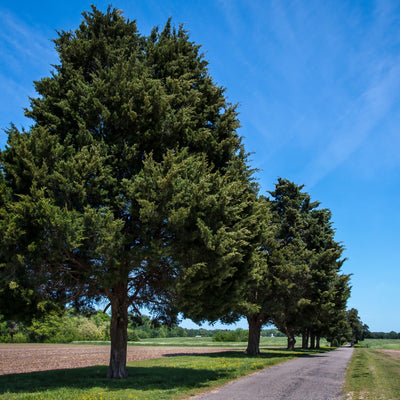Eastern Red Cedar Tree
Eastern Red Cedar Tree
Eastern Red Cedar Tree - Juniperus virginiana
A native of North America, the Eastern Red Cedar Tree has a range that extends from the Gulf of Mexico to southern Canada. This hardy species is characterized by a short reddish trunk and densely branched foliage that usually grows in a narrow cone or columnar shape. Young trees have needle-like leaves, but mature trees have scale-like vegetation. The evergreen foliage is a pleasing greenish-blue color during most of the year, but many cultivars change color in the winter to a reddish-brown. The Eastern Red Cedar is a dioecious species, meaning it has separate male and female trees, and each fall, the females sport deep blue-grey berries that are attractive to wildlife and birds. This hardy species is an easy tree to grow and does well from USDA hardiness zones 2-9. Though it prefers well-drained soils and full sun, it will tolerate a wide range of soils and growing conditions from swamps to rocky soils and everything from mild coastal weather to harsh winters and intermittent drought. The cedar is a slow-growing tree and may only grow as large as a medium shrub if it is planted in poor soil but typically reaches between 16–66 feet (5–20 m) tall. Because the Eastern Red Cedar tree can live for more than 900 years and is a low-maintenance tree, it is an excellent choice for landscaping. Be sure to plant cedars at least 20 feet from other extensive plantings and any buildings to prevent competition and stunted growth and to prevent the cedar's roots from undermining your house's foundation. Depending on the variety chosen, you can use them in several ways. Taller cultivars can make an effective windbreak due to their dense, upright growth or are used as a display specimen. Shorter varieties make a decorative and low-maintenance hedge.

